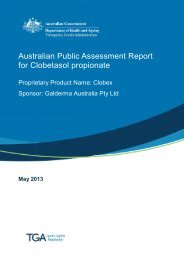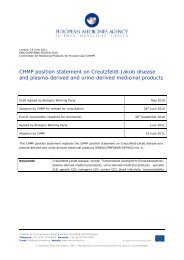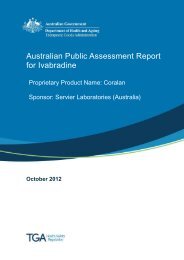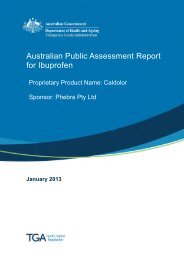AusPAR: Cabazitaxel - Therapeutic Goods Administration
AusPAR: Cabazitaxel - Therapeutic Goods Administration
AusPAR: Cabazitaxel - Therapeutic Goods Administration
You also want an ePaper? Increase the reach of your titles
YUMPU automatically turns print PDFs into web optimized ePapers that Google loves.
<strong>AusPAR</strong> Jevtana <strong>Cabazitaxel</strong> Sanofi-Aventis Australia Pty Ltd PM-2010-02565-3-4<br />
Final 9 February 2012<br />
<strong>Therapeutic</strong> <strong>Goods</strong> <strong>Administration</strong><br />
against P388 leukaemia. <strong>Cabazitaxel</strong> showed broadly similar activity to docetaxel when<br />
both were tested against the same docetaxel sensitive murine tumours.<br />
Intravenous (IV) cabazitaxel showed good activity against all 14 human xenografts in nude<br />
mice, although activity varied from moderate to high. Tested xenografts included a<br />
prostate carcinoma (DU 145), as well as mammary and colon adenocarcinomas,<br />
mammary, colon, lung, pancreatic, head and neck, and kidney carcinomas, glioblastomas<br />
and a gastric tumour. Most of the tested xenografts were treated at an advanced stage of<br />
disease and, with a few exceptions, treatment resulted in complete tumour regression in a<br />
proportion of the animals at doses that were non toxic. Long term tumour free survivors<br />
were observed for 6 tumour types (colon carcinoma HCT 116, pancreatic carcinoma MIA<br />
PaCa-2, head and neck carcinoma SR475, prostate carcinoma DU 145, and glioblastomas<br />
U251 and SF-295). Particularly good activity was observed against prostate carcinoma DU<br />
145, with complete regression in 6/6 mice at the 7.4 and 12 mg/kg/dose, with 3/6 and<br />
5/6 tumour free survivors (on Day 75) at these respective doses. The dose of 7.4 mg/kg<br />
corresponds to 22 mg/m 2 (using a mg/kg to mg/m 2 conversion factor of 3) which is<br />
similar to the proposed human dose of 25 mg/m 2, although frequency of dosing was<br />
higher in the mice studies compared to that proposed in humans.<br />
<strong>Cabazitaxel</strong> showed broadly similar activity to docetaxel when - tested against the same<br />
docetaxel sensitive human tumour xenografts. <strong>Cabazitaxel</strong> showed good activity against<br />
some xenografts against which docetaxel was poorly active (GXF-209 gastric tumour and<br />
UISO BCA-1 mammary carcinoma). <strong>Cabazitaxel</strong> crosses the blood brain barrier and it<br />
showed better activity than docetaxel against intracranially implanted human<br />
glioblastomas, U251 and SF-295.<br />
Activity against drug resistant cell lines<br />
The mechanisms leading to resistance to taxanes have not been fully elucidated but<br />
overexpression of P-glycoprotein (P-gp) appears to be one mechanism (Zunino et al.,<br />
1999). 7 <strong>Cabazitaxel</strong> was tested in vitro for activity against 20 drug resistant tumour cell<br />
lines (murine and human cell lines resistant to a number of standard cytotoxic drugs),<br />
including cell lines which overexpressed P-gp. Generally, in the resistant cell lines,<br />
cabazitaxel did not show any marked reduction in activity compared to activity against the<br />
parent cell line (that is, resistance to various cytotoxic drugs did not confer cross<br />
resistance to cabazitaxel).<br />
In general, resistance factors (IC50 resistant cell line/IC50 parent cell line) for cabazitaxel<br />
ranged from 0.5 to 10. In only 6 of the cell lines was the relative resistance factor >3, with<br />
the maximum resistance factor being about 10 for two resistant tumour cell lines. In a<br />
comparative study (cabazitaxel vs docetaxel) in 7 cell lines with acquired resistance to<br />
various cytotoxic drugs (doxorubicin, vincristine, vinblastine, docetaxel and paclitaxel)<br />
and which overexpressed P-gp, cabazitaxel had lower resistance factors (1.8−10) than<br />
docetaxel (4.8−59), probably reflecting a lower recognition of cabazitaxel than docetaxel<br />
by P-gp. MDR-1 (P-gp gene) expression levels correlated with docetaxel and cabazitaxel<br />
resistance, confirming a role for this transporter in resistance.<br />
Overall, the in vitro studies support the use of cabazitaxel in cancer patients previously<br />
treated with a docetaxel containing regimen.<br />
A limited number of resistant tumour cell lines were investigated in vivo (murine<br />
docetaxel resistant B16 melanoma and vincristine resistant P388 leukaemia, and human<br />
7 Zunino F, Cassinelli G, Polizzi D, Perego P. Molecular mechanisms of resistance to taxanes and<br />
therapeutic implications. Drug Resist Update 1999; 6: 351-357.<br />
Page 10 of 75
















